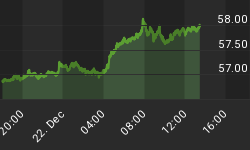With S&P 500 bank/financial stocks the worst performing sectors so far in 2007, it is becoming clear that the inverted yield curve has damaged investor confidence in the group. Conversely, with utility stocks the best performing sector this year, it is obvious that investors have continued their defensive hunt for yield. Suffice to say, given that financial stocks typically outperform early in the cycle and utilities tend to beat other sectors late (or in the down cycle), the action in 2007 would seem to suggest that the bear is growling.
The only problem with the above 'cycle' logic is that it doesn't take into account actual performance numbers. To be sure, with utility stocks already up a whopping 16.2% year-to-date (as measured by the XLU index) and financial stocks also in the black, sector analysis has become vain in the face of one simple conclusion: bull! In other words, it doesn't matter that gains have been stronger in defensive yield plays, because these gains are not arriving at the expense of other groups.
Incidentally, what has gone wrong for bearish forecasts thus far in 2007 isn't exactly a secret: corporate earnings have climbed faster than expected. And although many bears are quick to warn of the growing disconnect between strong corporate earnings growth and sluggish U.S. economic growth, that nearly 50% of S&P 500 earnings was generated from abroad in 2006 is reason enough to give any prognosticator pause. As silly as this may have sounded only a few months ago, U.S. economic activity could flatten and corporate earnings could still continue to rise, at least until the unstable moorings underpinning global growth are shaken...
When Will Confidence in Utilities Be Shaken?
As the timely and profitable Wish List position in Great Plains Energy highlighted, as recently as last year there were some opportunities in the utilities group. Moreover, with a long-term approach some potentially attractive opportunities can still be talked about today (for example, former Wish List stock, Hawaiian Electric, yields 4.9%, and given its regulatory successes could be a desirable covered call consideration). Nevertheless, what cannot be ignored when studying the diverse utilities group is that the stocks, on average, yield less than cash does in some savings accounts, let alone a 1-year money market fund. Moreover, and as the recent activity in REITs can attest to, stretched fundamentals along with less than attractive yields can lead to a devastating fallout when the selling starts (REITs have been crashing on a relative basis in recent weeks ~ pg. 2 PDF).
But when will the selling start? Last year around this time we released our top-30 utility takeover targets and - not including the one company that has been acquired - the average gain since has been 31.2%, or double the average gain in the utilities group. Given that no set of fundamentals has backed this surge, these gains comment well on previous sentiments; that this has been a historic rally in anything with yield, and, apparently, any yield will do.
In short, exactly when the investor rush into utilities will reverse course is a difficult question to answer. Indeed, in a financial world keyed on the earnings mirror and nondescript liquidity dealings rather than actual business fundamentals and the myriad of ominous obstacles that may lurk ahead, there is no sundial to timely measure future changes in investor sentiment. But make no mistake: utilities, as measured by annual appreciation in the XLU since 2003, have little chance of generating 25+% annual returns before dividends going forward, and the contrarian conclusion that a reckoning is near draws deeper tones with every move higher in the group. The question is, how many utility enthusiasts have been fooled into believing that their dividends offer protection during a bear market?
Disclosure: No one at FallStreet.com has any investment position in the companies mentioned above.
















